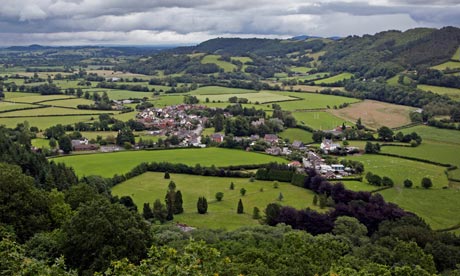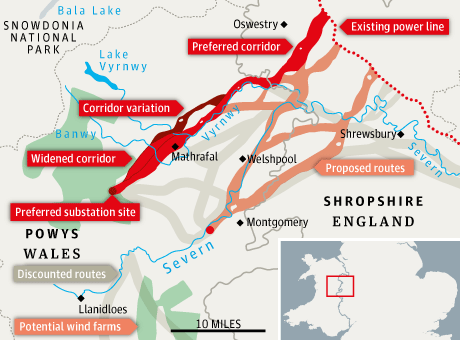Campaigners dismayed as controversial Powys pylon route revealed
Network of more than 100 pylons serving windfarms in mid-Wales will travel through Vyrnwy valley

Meifod in the Vyrnwy valley, Wales, the route for new pylons that service windfarms. Photograph: David Sillitoe for the Guardian
Campaigners have vowed to continue their fight against onshore wind farms in mid-Wales after the National Grid selected the route for high-voltage pylons along the picturesque Vyrnwy valley.
The pylons and a major new substation at Cefn Coch in Powys will connect the proposed windfarms to the high voltage electricity network in Shropshire using a combination of overhead lines and underground cables.
National Grid said it had listened to concerns that the Vyrnwy valley was particularly sensitive to an overhead line and is considering an alternative route that would skirt part of the valley and bypass the historic village of Meifod, where opposition is particularly strong. Putting the cables underground in the Vyrnwy valley is believed to be too difficult in an area that regularly floods. Preferred route of the mid-Wales pylons
Preferred route of the mid-Wales pylons
 Preferred route of the mid-Wales pylons
Preferred route of the mid-Wales pylons
Jonathan Wilkinson, chairman of Montgomeryshire Against Pylons, said campaigners were "disappointed but not surprised" by the route chosen by National Grid.
"If they wanted to choose a route to maximise opposition, they've chosen it. If they wanted a fight, they've certainly got one now," he said.
Up to 500 local people are expected to gather at the site of the proposed substation tonight to demonstrate their opposition to the plans but Wilkinson said efforts would now focus on blocking the proposals for six major windfarms in mid-Wales.
The National Grid has said that if these windfarms are not constructed then the substation and the new pylon route will not be built.
Two of the windfarms will go to a public inquiry next year with four other proposals certain to be rejected by Powys council, which is controlled by anti-windfarm independents.
These four proposals could be included in a single public inquiry, which would be the focus of major popular opposition in mid-Wales. A vocal majority in the sparsely populated region are opposed to both the wind farms and the pylons, likening it to the flooding of the valleys to supply water to English cities in previous decades.
Jeremy Lee, lead project manager for National Grid said: "We will carry on listening to local views and these will play an important role as our plans progress. We understand people have concerns about overhead lines, but where they are used, we will work hard to reduce any visual effects by routing the line carefully and using appropriate pylon designs which could include the new T-pylon."
It will take at least three years in planning before work begins on the substation and cables in Powys. Ultimately, the fate of mid-Wales' pre-industrial beauty lies with the Department of Energy and Climate Change – and any further cuts to the current subsidy regime for onshore wind.
Wilkinson admitted the latest cut to the subsidy regime for onshore wind"was not enough" to place the mid-Wales schemes in doubt but he hoped the government would make further cuts when renewable funding is reviewed in 12 months' time.
While many environmental groups are in favour of onshore wind, Montgomeryshire and Shropshire Wildlife Trusts have declared their opposition to the large-scale projects like those in mid-Wales. "The impact on the area's wildlife could be devastating," said the trusts in a joint statement last year, questioning the wisdom of treating wind poweras the primary form of renewable energy and concentrating mega-farms in areas far from demand.
They also pointed out that "mitigation measures" taken by wind developments to compensate for loss of species and habitats had been a "widespread failure" so far.
No hay comentarios:
Publicar un comentario